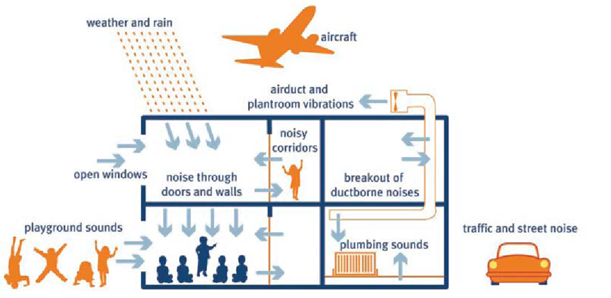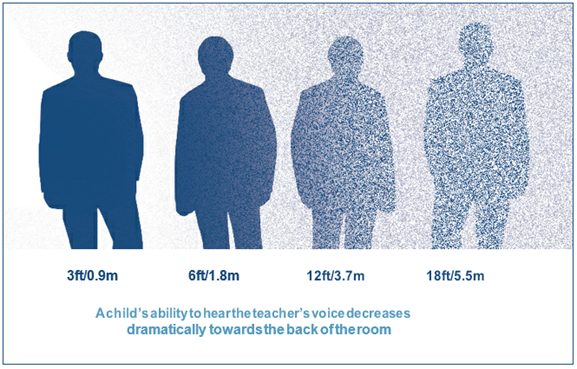Creating good listening conditions: For education settings
“We would never teach reading in a classroom without lights. Why then would we teach in ‘acoustic darkness’? Speaking to a class, especially of younger children, in a room with poor acoustics, is akin to turning out the light.”
- Professor John Erdreich, Scientific Counsel in Acoustics
This information will help school managers (and managers in other education settings) to create good listening conditions for pupils.
Research shows that good listening conditions in schools will:
- improve learning and retention of information for all children, and especially those who are deaf, have a temporary hearing loss (glue ear, for example) or other additional learning needs
- improve behaviour in the classroom
- reduce teacher absences
- make sure that deaf children get the most out of their hearing.
Taking steps to improve the acoustics in your school will help demonstrate to parents that you are making reasonable adjustments under equality legislation to meet the needs of disabled pupils.
We have a collection of resources that will help assess and improve listening conditions in learning environments.
You can download the resources below:
- Managing listening conditions checklist
- Preliminary noise survey
- Pupil survey
- Presentation for Teachers of the Deaf
You can also find out more about what schools can do to improve listening conditions.
Why are good listening conditions so important?
There’s a strong link between good acoustics and achievement for all pupils. For example, a study of 142 schools in England showed that there was a direct link between the level of classroom noise and pupils’ Key Stage 2 Maths results.
Many children experience temporary hearing loss, such as glue ear, at an age when listening to develop spoken language is critical. It’s estimated that eight out of ten children will have had at least one episode of glue ear by the time they are 10 years old.
Evidence shows that poor classroom acoustics can create a negative learning environment for many pupils, especially those who are deaf, have learning difficulties, or pupils who have English as an additional language.
Alan Steer’s report, Learning Behaviour, argues that the surroundings in which children work and learn have a major impact on behaviour. He states that: “Architects and contractors should pay special attention to acoustics and lighting in classrooms to support pupil participation in lessons”.
Research shows that teachers have more cases of throat problems than any other professional group, and this can be made worse by having to project their voices over classroom noise. Eighty-six percent of teachers reported that classroom noise caused them problems and 80% reported vocal strain and throat problems. Forty-nine percent had to strain their voices to be heard, and overall teachers were 32% more likely than other professions to have voice problems that caused them to take time off work.
Hearing aids and cochlear implants can’t cut out background noise. In fact, they make all noises in a classroom louder (not just the teacher’s voice) meaning that a deaf child may struggle to hear their teacher if there is a lot of background noise.
Many schools have soundfield systems but its effectiveness is dependent on the acoustics of the room.
Why do children find it challenging to listen in class?
“People can fill in the blanks of missed information only if they have that information already stored in their brain’s ‘data bank’ from where they can retrieve it. Because they do not have those data banks, children need a sharper auditory signal than adults do. Thus, while a classroom might sound fine to an adult, it may be woefully inadequate for typical children who are neurologically undeveloped or have not had decades of language and life experience. All this means that children require a quieter environment and a louder signal than adults do in order to learn.” Carol Flexer, Professor of Audiology
Children working in an exciting, interactive classroom will inevitably make noise. But there are other noises which don’t have a positive impact on a learning environment, such as noise coming from other rooms and from outside the school building. These noises can have an impact on a child’s ability to listen in class.

For children to understand what a teacher is saying, the teacher’s voice needs to be louder than any background noise. If a classroom is noisy (or what is sometimes called a low signal to noise ratio) most teachers will have difficulty speaking loudly enough so that pupils can understand.

Reverberation happens when the sound from a source has stopped, but reflected sound continues in the room. If surfaces have a low absorbency and are reflective, like concrete, then the sound may bounce around the room. It then arrives at the child’s ear at different times, blurring the sound and making it difficult to listen and understand the message. The longer the reverberation time the more blurred the message, and the greater the impact on learning.
The younger the child, the greater the need for a good listening environment. Pupils with limited language ability will also rely on good listening conditions to be able to follow what a teacher is saying.
Listen to these sound clips to experience how a child with a high frequency loss might hear in a noisy classroom.
Equality Act 2010: Duty to make reasonable adjustments
The Equality Act 2010 applies to all education providers and local authorities in England, Scotland and Wales. The Act requires schools and local authorities to make reasonable adjustments so that disabled pupils are not put at a substantial disadvantage in accessing the curriculum, teaching and learning. The Act also requires education providers to proactively anticipate the needs of disabled pupils. Some of the measures we’ve described in this booklet would constitute reasonable adjustments for deaf pupils.
Northern Ireland is not covered by the Equality Act but has its own anti-discrimination legislation: the Disability Discrimination Act 1995 and the Special Educational Needs and Disability Order (NI) 2005. Although the legislation is different, many of the principles are the same.
Planning duties for schools and local authorities
Local authorities in all four countries of the UK must produce strategies to make education more accessible for disabled pupils.
These strategies should aim to:
- increase the extent to which disabled pupils can participate in the curriculum
- improve the physical environment of schools so that pupils can take better advantage of education, benefits and facilities
- improve the availability of accessible information for disabled pupils.
They should set out what the local authority will contribute to the schools it maintains and what is expected from those schools.
Legislation on special educational needs/additional support for learning
In all four countries of the UK, disabled pupils with higher levels of need may have a statutory plan (such as statement of special educational needs, an Education, Health and Care plan or a coordinated support plan). These statutory plans may set out what improvements are needed to help the pupil achieve the best possible educational outcomes.
England
The Department for Education’s guide: Acoustic Design of Schools: Performance standards (2014) sets out expectations and explains the steps that local authorities and schools need to take to comply with the School Premises Regulations (2012).
You can find more detailed guidance in Acoustics of Schools: A design guide (2015), which has been produced by the Association of Noise Consultants (ANC) and the Institute of Acoustics (IOA). It provides some of the more technical information that was previously in Building Bulletin 93.
Wales
Building regulations are devolved in Wales and Building Bulletin 93 continues to be used there. Schools built and refurbished under the 21st Century Schools programme must take part in a pre-completion test to show that they comply with acoustic standards in Building Bulletin 93. If the building fails to meet the acoustic standard, remedial steps should be taken to ensure compliance, along with further testing to demonstrate that the school now meets the standards.
Scotland
In Scotland, statutory requirements for school environmental conditions are outlined in the School Premises (General Requirements and Standards) (Scotland) Regulations 1967. Regulation 24 states that: “Every part of the school building shall have acoustic conditions and insulation against disturbance by noise appropriate to the use for which the part of the building is designed.” Adherence to Building Bulletin 93 is widely seen as a way to show compliance with this regulation.
The Scottish Government’s guidance, School Design: Optimising the Internal Environment – Building our future, Scotland’s school estate (2007) is intended to help local authorities to develop design brief documents for a range of environmental conditions in schools, including acoustics. Both Building Bulletin 93 and Building Bulletin 101 are referred to in this document as “the starting point for design guidance”. While there are no specific regulatory requirements, there are areas of effective practice where Building Bulletin 93 has been fully implemented in new school builds.
Northern Ireland
An amended version of Building Bulletin 93 was introduced in Northern Ireland in 2007. New build schools in Northern Ireland have to be tested acoustically to ensure that the requirements in Building Bulletin 93 have been met. If the requirements aren’t met, schools have to take action. The Department of Education will not fund these measures so it’s vital that acoustics are right from the start.
